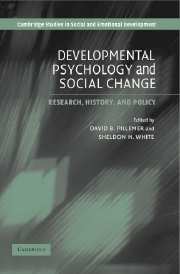Book contents
- Frontmatter
- Contents
- Preface
- List of Contributors
- Introduction: What Kind of Science Is Developmental Psychology?
- Part One The Developing Child: Global and Historical Perspectives
- 1 The Globalization of Developmental Psychology
- 2 A Socio-historical Perspective on Autobiographical Memory Development
- 3 Toward a Better Story of Psychology: Sheldon White's Contributions to the History of Psychology, A Personal Perspective
- Part Two Designing Child and Family Policies
- Part Three Designing Child Health Policies
- Part Four Designing Effective Learning Environments for Children and Adolescents
- Index
- References
2 - A Socio-historical Perspective on Autobiographical Memory Development
Published online by Cambridge University Press: 03 December 2009
- Frontmatter
- Contents
- Preface
- List of Contributors
- Introduction: What Kind of Science Is Developmental Psychology?
- Part One The Developing Child: Global and Historical Perspectives
- 1 The Globalization of Developmental Psychology
- 2 A Socio-historical Perspective on Autobiographical Memory Development
- 3 Toward a Better Story of Psychology: Sheldon White's Contributions to the History of Psychology, A Personal Perspective
- Part Two Designing Child and Family Policies
- Part Three Designing Child Health Policies
- Part Four Designing Effective Learning Environments for Children and Adolescents
- Index
- References
Summary
Introspection leaves the impression that personal event memories are private, self-generated products of an individual's experience in the world. When we reflect on the past, “we can accept with little question that biography or the lifetime is the appropriate or ‘natural’ frame for individual memory” (Schudson, 1995, p. 346). Historically, investigations of memory processes have resided at this phenomenologically justified level of analysis. For example, early studies focused on the nature of adults' childhood memories with limited reference to the particulars of history or other contextual factors situated outside the individual (e.g., Dudycha & Dudycha, 1941; Sheingold & Tenney, 1982; Waldfogel, 1948).
In the past several decades, memory researchers have gained an increasingly sophisticated perspective on context. Autobiographical memory offers a rich platform from which to view contextual effects, and research on the topic has benefited from this perspective. Currently, theory and burgeoning empirical evidence support the notion that both proximal and distal influences have the potential to shape autobiographical remembering in complex ways (Bronfenbrenner, 1979; Ceci & Leichtman, 1992; Leichtman, Wang, & Pillemer, 2003; Wang, 2003).
In the present chapter, we consider context through an exceptionally broad lens. Our overarching goal is to identify the possible roles that socio-historical factors, including government policies and culturally shaped aspects of the social environment, play in shaping the personal event memories of individuals. Researchers have only recently begun to consider connections between such macro-level environmental elements and the personal sphere of autobiographical memory; thus, some of the ideas that follow are speculative.
- Type
- Chapter
- Information
- Developmental Psychology and Social ChangeResearch, History and Policy, pp. 34 - 58Publisher: Cambridge University PressPrint publication year: 2005
References
- 2
- Cited by



